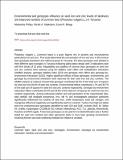| dc.description.abstract | Phaseolus vulgaris L. (common bean) is a grain legume rich in proteins and micronutrients particularly iron and zinc. This study determined the concentration of iron and zinc in 99 common bean genotypes (landraces and cultivars) grown in Tanzania. The bean genotypes were planted in three different agro-ecologies in Tanzania following alpha lattice design with 3 replications each with five blocks of 20 plots. Adaptability and stability of common bean genotypes on seed iron and zinc contents were assessed using the additive main effect and multiplicative interaction (AMMI) analysis, genotype stability index (GSI) and genotype main effect plus genotype-by-environment interaction (GGE). Highly significant effects of bean genotypes, environments, and genotype by environment interaction were observed for both seed iron and zinc contents. The AMMI analysis of variance showed that genotype contributed 69.5% of the total sum of squares for seed iron and 28.6% of seed zinc contents. Environmental effects contributed 1.7% and 39.7% of the total sum of squares for seed iron and zinc contents respectively. Genotype by environment interaction effects contributed 26.3% and 28.6% of the total sum of squares for seed iron and zinc contents respectively. Among individual weather and soil parameters of the experimental sites, total rainfall, soil available phosphorus, iron, silt %, and exchangeable potassium positively significantly influenced the contents of seed iron, while temperature, total soil nitrogen, and manganese influenced negatively and significantly seed iron contents. Twelve most high and stable seed iron-containing bean genotypes identified by both GSI and GGE, includes SMC 18, Selian 94, Urafiki, Kyakaragwe, CODMLB 033, Kikobe, Malirahinda, ACC 714, Jabeyila, Mwamikola, Kasukari and Wifi nygela. These bean genotypes can be used for iron biofortification and or further tested for seed iron contents and other agronomic traits in more bean growing environments involving farmers and seed certifying institutes for release as varieties. | en_US |

